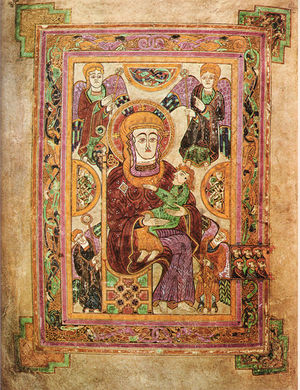Illuminated manuscripts are manuscripts where the “text is supplemented by the addition of decoration or illustration, such as decorated initials, borders, and miniatures” (wikipedia). In the truest since of the word, an illuminated text only refers to “manuscripts decorated with gold or silver” (Wikipedia). But today’s scholars are now using the term to refer to any manuscript that is decorated (Wikipedia). Most manuscripts that are still around today are texts from the Middle Ages, but there are many “illuminated manuscripts [that] survive from the 15th century Renaissance, along with a few from antiquity” (Wikipedia). A great example of an exceptional illuminated manuscript is The Book of Kells.
The Book of Kells is housed at Trinity College in Dublin, Ireland. Trinity College is the oldest university in Ireland and was established by Queen Elizabeth I in 1592″ (Culture Vulture). If one would like to view The Book of Kells, it can be seen amidst the ambiance of the Old Library inside the “extraordinary Long Room” (Culture Vulture). It is displayed dimly in “conservation light” and is only displayed four pages at a time (Culture Vulture). This setting helps to lend a sense of mystery and intrigue to the book. The college in Dublin is the perfect home for this ancient book.
The Book of Kells is believed to be a book that was not used for everyday use, but rather used at the altar only for special occasions (Culture Vulture). The size and shape as well as the great detail of the pages leads one to conclude that this is the most likely case for the use of the book. It contains the four gospels of the Bible (which are the history of the life of Christ). The gospels were copied from Latin by scribes onto vellum. It has been estimated that “185 calf’s skins were used for this book” (Culture Vulture).
The book is a handsome example of illuminated texts. It has many embellishments and illustrations drawn in brilliant colors and is considered to be a masterpiece of medieval artwork. (Culture Vulture).
The glowing colors were achieved with an astonishing range of pigments, from crushed oak apples to lapis lazuli to beetles’ wings. Complex imagery with multiple symbolic meanings include peacocks, snakes, animals, spirals and triskeles, and of course, crosses of various styles. Images of saints are used , some rendered with great style and draftsmanship. Together these elements achieve both an immediacy and sense of mystery; scholarly research will doubtlessly continue to interpret and reinterpret the work endlessly.” (CultureVulture).
The Book of Kells is believed to have been created around 800 A.D. The decorated pages in the book often are found on single sheets, but some of the pages artwork is on both sides in a bifolia form (Wikipedia).
The text in the manuscript is written in “Insular majuscule, with some minuscule letters usually “c” and “s”” (Wikipedia). Scholar Francoise Henry has noted that it appears that at least three scribes were used to create the book. She identified these hands as Hand A, Hand B and Hand C (Wikipedia). She identified the different hands by the lines per page that they wrote, the ink they used, and the tendency of the type of script they used. Hand C, for example, had a tendency to use minuscule script (Wikipedia).
The Book of Kells is a fabulous example of an illuminated manuscript, and it is easy to see that the decoration of the book was extremely important. The illumination appeared to be even more important than the text, which is evident by the “number of differences between the text and accepted gospels” (Wikipedia). One of the first errors in the text is found in Luke 3:23 where “erroneous names
